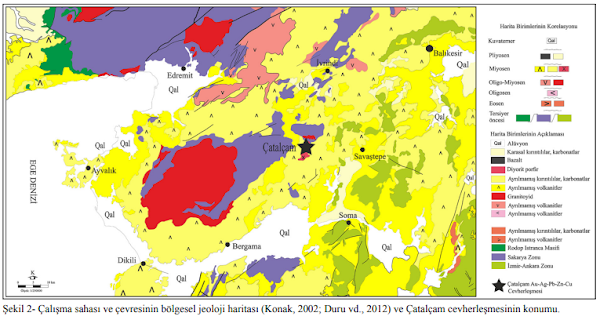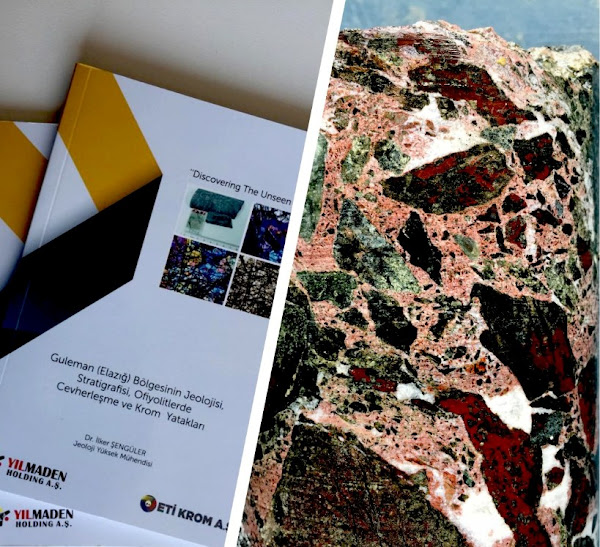VOLCANOGENIC MASSIVE SULFIDE (VMS) DEPOSITS OF TURKEY
E. Çiftçi, C. Dönmez, K. Günay, N. Yıldırım
September 2018, 15th Quadrennial IAGOD International Association on the Genesis of Ore Deposits Symposium
Volcanogenic massive sulfide (VMS) deposits of Turkey occur in three tectonically distinct regions: (I) Kuroko type deposits in the eastern Pontides Tectonic belt (EPTB); (II) Cyprus- type VMS deposits occur both in Küre area (Kastamonu) and along the Bitlis-Zagros Suture Zone (BZSZ), and (III) Besshi-type VMS deposits in the Hanönü– Tasköprü area (Kastamonu). The Kuroko type VMS deposits, ranging from a few ten thousand tonnes to a few ten million tonnes in reserve, are all associated with Late Cretaceous felsic volcanics. These consist mainly of dacitic and rhyolitic lavas and pyroclastics that outcrop within a narrow zone running parallel to the Black Sea coast and represent the axial zone of a paleo magmatic arc. Subtypes of the deposits include Cu-, Zn-Cu-, Cu-Zn-, Zn-Pb-Cu metal associations. These deposits are typically mined for Cu, Zn, and Pb. Some of them may also contain significant gold (e.g. Cerattepe deposit) and silver (e.g. Köprübaþı deposit). The Cyprus type deposits of Turkey occuring along the BZSZ are all allochthonous and associated with mafic volcanics of supra-subduction ophiolites: (I) Middle Eocene Maden Complex – a pile of mafic volcanics, pelagic sediments with limestone blocks and (II) Late Triassic-Late Cretaceous Koçali Complex – a sequence of tectonically imbricated slices of pelagic rock suites, platform carbonates, clastic sediments, serpentinites, and mafic volcanics. Major occurences include Madenköy (Sirvan-Siirt) – currently the largest VMS deposit in Turkey with about 40 Mt reserve and Maden (aka Ergani) (Maden-Elazığ) both hosted by the Maden Complex and Ortaklar (Gaziantep) hosted by the Koçali Complex. The VMS deposits occurring in the Küre area are also allochthonous and are all hosted within mafic volcanics-black shales of Late Triassic Küre Complex, a fairly thick pile of thrust- imbricated deep-sea sediments, intercalated with a dismembered supra-subduction ophiolite. Major past and current producers include Aþıköy, Toykondu, Kızılsu, and Bakibaba (Maðaradoruk is a recently discovered ore body in the same area) deposits. All of these Cyprus-type deposits are mined mainly for Cu, however Zn, Co (e.g. Maðaradoruk) and Au (e.g. Ortaklar) may reach economic grades. The Besshi-type VMS deposits of Turkey are fairly recent discoveries. They only occur in Hanönü-Tasköprü area (Kastamonu). These are hosted by Akgöl Formation, which consists of low-grade metamorphic siliciclastic sedimentary rocks within the Middle Jurassic Çangaldað Complex comprising ensimatic island arc volcanics and front-arc basin sediments, remnants of oceanic crust, and volcano-clastics, which itself occurs in the Central Pontides. Major examples include Zeybek, Hanönü, Gökırmak, and past producer Cozoðlu deposits. Deposits of the area are typically low grade but may reach up to 25 Mt (e.g. Gökırmak deposit).
KAYNAKLAR:
1.https://www.researchgate.net/publication/327622596_VOLCANOGENIC_MASSIVE_SULFIDE_VMS_DEPOSITS_OF_TURKEY
2. http://earthsci.org/mineral/mindep/ma_sulp/ma_sulp.html
3. https://www.mta.gov.tr/dosyalar/images/dogalkaynaklar/makaleler/503/tr_20221025113958_503_4_eb0193ee.pdf
September 2018, 15th Quadrennial IAGOD International Association on the Genesis of Ore Deposits Symposium
Volcanogenic massive sulfide (VMS) deposits of Turkey occur in three tectonically distinct regions: (I) Kuroko type deposits in the eastern Pontides Tectonic belt (EPTB); (II) Cyprus- type VMS deposits occur both in Küre area (Kastamonu) and along the Bitlis-Zagros Suture Zone (BZSZ), and (III) Besshi-type VMS deposits in the Hanönü– Tasköprü area (Kastamonu). The Kuroko type VMS deposits, ranging from a few ten thousand tonnes to a few ten million tonnes in reserve, are all associated with Late Cretaceous felsic volcanics. These consist mainly of dacitic and rhyolitic lavas and pyroclastics that outcrop within a narrow zone running parallel to the Black Sea coast and represent the axial zone of a paleo magmatic arc. Subtypes of the deposits include Cu-, Zn-Cu-, Cu-Zn-, Zn-Pb-Cu metal associations. These deposits are typically mined for Cu, Zn, and Pb. Some of them may also contain significant gold (e.g. Cerattepe deposit) and silver (e.g. Köprübaþı deposit). The Cyprus type deposits of Turkey occuring along the BZSZ are all allochthonous and associated with mafic volcanics of supra-subduction ophiolites: (I) Middle Eocene Maden Complex – a pile of mafic volcanics, pelagic sediments with limestone blocks and (II) Late Triassic-Late Cretaceous Koçali Complex – a sequence of tectonically imbricated slices of pelagic rock suites, platform carbonates, clastic sediments, serpentinites, and mafic volcanics. Major occurences include Madenköy (Sirvan-Siirt) – currently the largest VMS deposit in Turkey with about 40 Mt reserve and Maden (aka Ergani) (Maden-Elazığ) both hosted by the Maden Complex and Ortaklar (Gaziantep) hosted by the Koçali Complex. The VMS deposits occurring in the Küre area are also allochthonous and are all hosted within mafic volcanics-black shales of Late Triassic Küre Complex, a fairly thick pile of thrust- imbricated deep-sea sediments, intercalated with a dismembered supra-subduction ophiolite. Major past and current producers include Aþıköy, Toykondu, Kızılsu, and Bakibaba (Maðaradoruk is a recently discovered ore body in the same area) deposits. All of these Cyprus-type deposits are mined mainly for Cu, however Zn, Co (e.g. Maðaradoruk) and Au (e.g. Ortaklar) may reach economic grades. The Besshi-type VMS deposits of Turkey are fairly recent discoveries. They only occur in Hanönü-Tasköprü area (Kastamonu). These are hosted by Akgöl Formation, which consists of low-grade metamorphic siliciclastic sedimentary rocks within the Middle Jurassic Çangaldað Complex comprising ensimatic island arc volcanics and front-arc basin sediments, remnants of oceanic crust, and volcano-clastics, which itself occurs in the Central Pontides. Major examples include Zeybek, Hanönü, Gökırmak, and past producer Cozoðlu deposits. Deposits of the area are typically low grade but may reach up to 25 Mt (e.g. Gökırmak deposit).
KAYNAKLAR:
1.https://www.researchgate.net/publication/327622596_VOLCANOGENIC_MASSIVE_SULFIDE_VMS_DEPOSITS_OF_TURKEY
2. http://earthsci.org/mineral/mindep/ma_sulp/ma_sulp.html
3. https://www.mta.gov.tr/dosyalar/images/dogalkaynaklar/makaleler/503/tr_20221025113958_503_4_eb0193ee.pdf







Yorumlar
Yorum Gönder